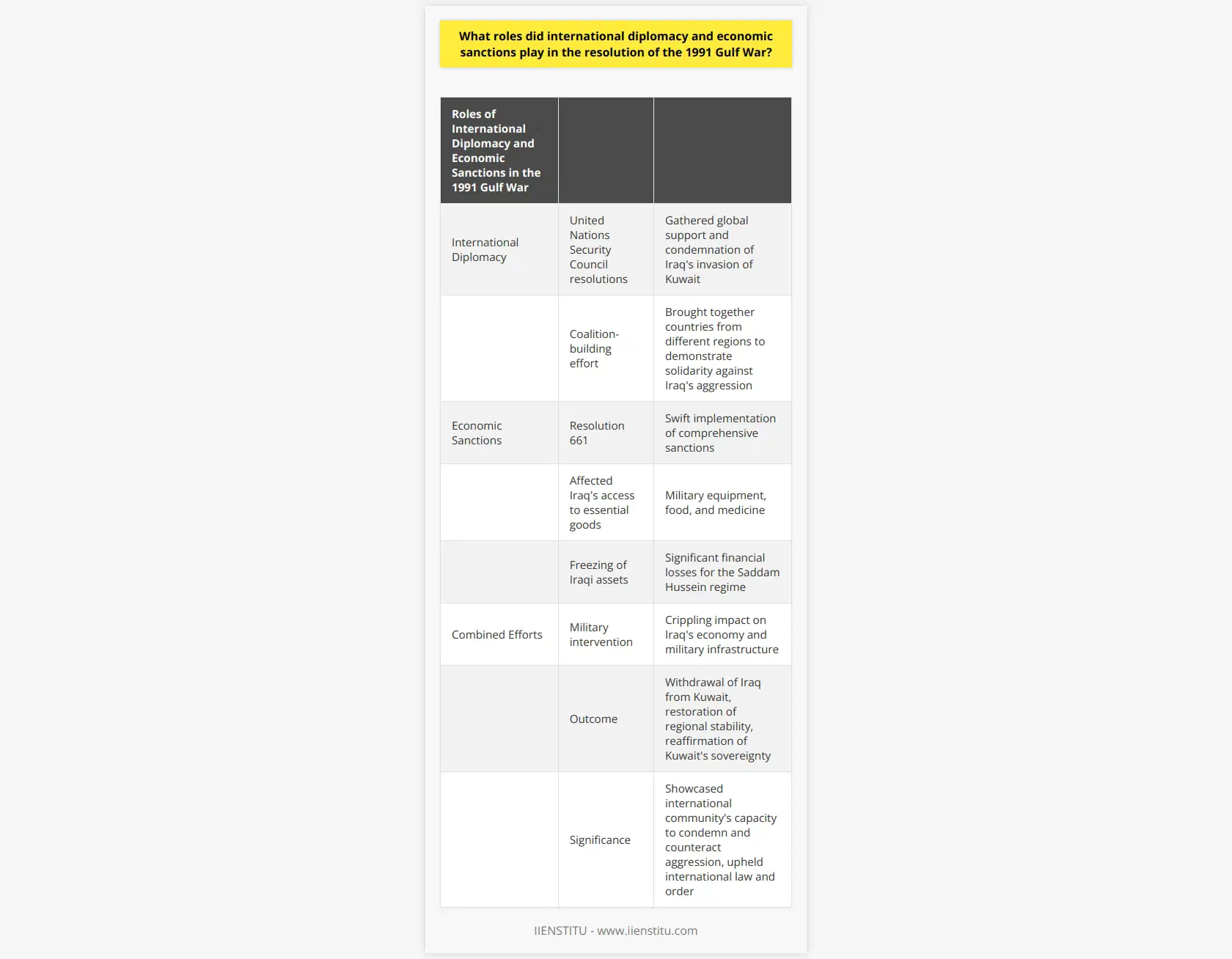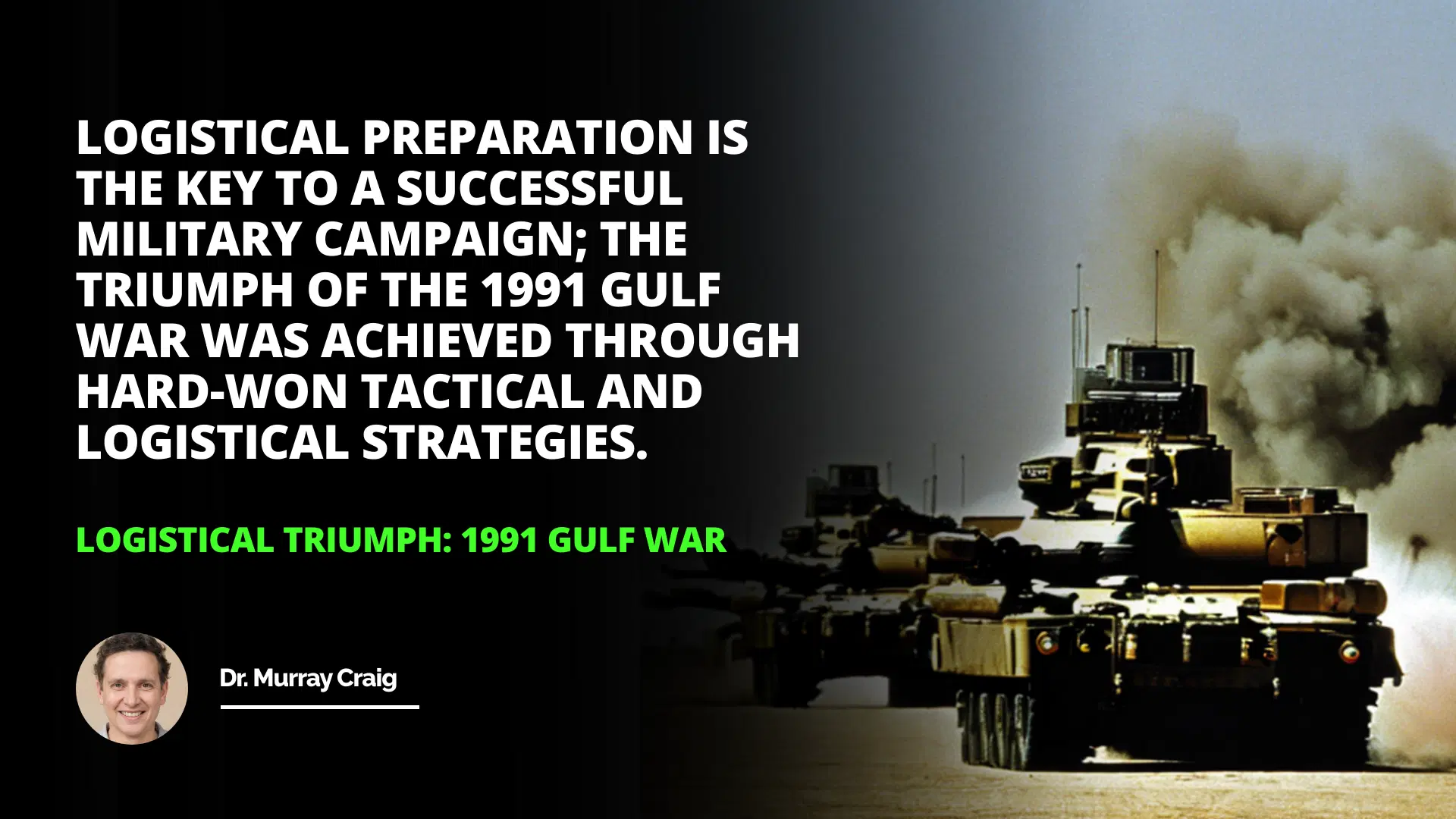
I still vividly remember the evening of January 16, 1991. I was sitting with my family around the dinner table when news broke that the United States, along with its coalition allies, had commenced Operation Desert Storm. The initial shock and concern were palpable, but little did we know the intricate logistical marvel unfolding behind the scenes that would lead to a swift and decisive victory in the Gulf War.
Logistical Details of the Gulf War
Resulting Triumphs
The Unsung Heroes: Logistics Behind the Victory
When we talk about wars, we often focus on the battles, the strategies, and the heroes on the front lines. However, the true backbone of any military success lies in its logistics. The 1991 Gulf War is a prime example of how meticulous planning and efficient supply chain management can turn the tides in one's favor.
Pre-Planning: The Foundation of Success
Before the first boots touched the hot sands of the Middle East, the United States military had already laid out an extensive logistical blueprint. I once read in a military journal that "amateurs talk about tactics, but professionals study logistics". This couldn't be truer for the Gulf War.
Deploying Half a Million Troops: Imagine coordinating the movement of over 500,000 troops from various parts of the world. It wasn't just about moving people but ensuring each soldier had the necessary equipment, food, and medical supplies.
Global Coordination: Troops were airlifted from Western Europe, the United Kingdom, the United States, and even countries like Egypt and India. This required unprecedented international cooperation.
I recall a neighbor who served as a logistics officer during the war sharing stories of endless nights ensuring that every single piece of equipment was accounted for. His tales highlighted the sheer magnitude of planning required to orchestrate such a massive operation.
Overcoming Deployment Challenges
The Persian Gulf region, at that time, lacked the infrastructure to support such a large-scale military presence. But, as they say, necessity is the mother of invention.
1- Air Transport Marvels: Up to 2,000 cargo flights were dispatched, carrying everything from tanks to toothbrushes.
2- Establishing New Infrastructure: A unique railroad system and port facilities were constructed in Saudi Arabia almost overnight. This reminded me of reading about the Transcontinental Railroad and how it transformed America's landscape.
Railroads: Facilitated the rapid transshipment of matériel across vast distances.
Ports: Allowed for the docking of massive ships carrying essential supplies.
The Edge of Technology: Specialized Equipment
One aspect that often gets overlooked is the use of advanced technology to optimize the supply chain management process.
Analyzing the Impact of Gross Margin Return on Investment (GMROI)
Crucial Aspects and Importance of Freight Rate Audit in Supply Chain
Unpacking Freight Consolidation: Benefits, Challenges & Strategies
Global Positioning System (GPS): At a time when GPS was not as ubiquitous as today, the military leveraged it to navigate the challenging desert terrain. This italicized text truly underscores the innovative spirit.
Aircraft Maintenance and Munitions Support Systems (AMMS): These systems ensured that aircraft and military vehicles were maintained efficiently, reducing downtime and increasing effectiveness.
Computer-Aided Design Software: Utilized for planning bombing missions with pinpoint accuracy.
I sometimes wonder how different things would have been without these technological advancements. It's like trying to find a needle in a haystack without a magnet.
Triumphs Born Out of Logistics
The result of all this meticulous planning and innovative deployment was a swift victory that many hadn't anticipated.
Rapid Buildup and Mobility
The efficient movement of troops and equipment meant that the coalition forces were ready to engage much sooner than Saddam Hussein had expected.
Utilizing Local Infrastructure: By tapping into existing ports, roads, and railways, and enhancing them, the coalition forces ensured a steady flow of supplies.
Air Superiority: The extensive air coverage not only provided defense but also ensured that supplies could be air-dropped to even the most remote units.
The Psychological Edge
There's an old saying: "An army marches on its stomach". Knowing that they were well-supplied boosted the morale of the coalition troops. On the flip side, the overwhelming display of logistical prowess had a demoralizing effect on the Iraqi forces.
Logistical preparation is the key to a successful military campaign. The triumph of the 1991 Gulf War was achieved through hardwon tactical and logistical strategies.
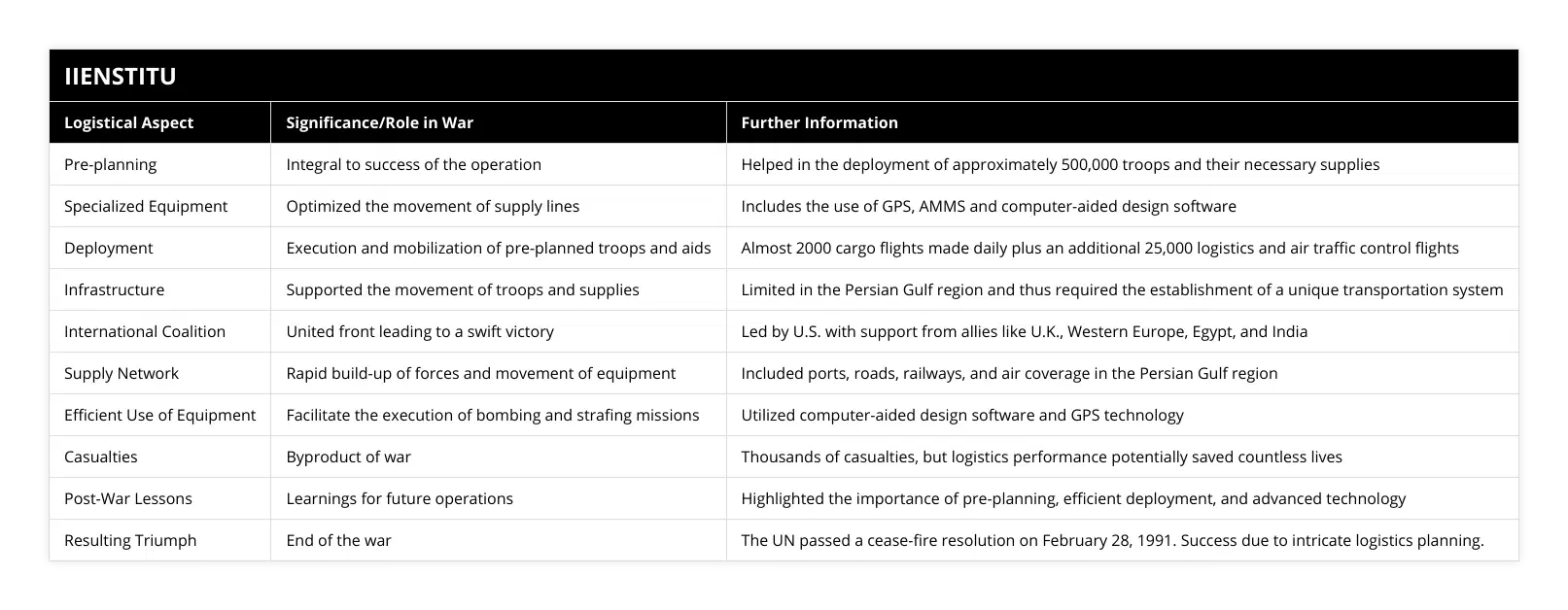
Consistent Supplies: Regular meals, equipment maintenance, and medical support kept the troops in peak condition.
Technological Superiority: The use of advanced technology showcased a level of preparedness that the opposition couldn't match.
I remember watching interviews of soldiers returning from the Gulf, emphasizing how well taken care of they were, sometimes even in the harshest conditions. It was heartwarming and a testament to the importance of logistics.
Lessons Learned and Future Implications
The Gulf War wasn't just a military victory; it was a masterclass in supply chain management. Businesses and military organizations worldwide took notes.
Collaboration is Key
The cooperation between nations demonstrated that collective efforts yield greater results.
International Coalition: Countries with different cultures and languages came together seamlessly.
Shared Resources: Pooling resources meant that the burden didn't fall on a single nation's shoulders.
Technological Integration
The war highlighted how integrating technology can optimize processes beyond traditional methods.
Real-Time Tracking: GPS allowed for real-time tracking of assets, something businesses strive for even today.
Data Management: Efficient handling of vast amounts of data ensured informed decision-making.
Optimize Supply Chain Management Process Tips
As someone who's dabbled in supply chain management, here are a few tips inspired by the Gulf War's logistics:
1- Advance Planning: Always have a detailed plan but remain flexible for adjustments.
2- Leverage Technology: Utilize the latest tech tools for tracking and data analysis.
3- Build Strong Partnerships: Collaborate with other organizations to strengthen your supply chain.
4- Invest in Infrastructure: Sometimes, building or upgrading infrastructure can save time and costs in the long run.
5- Train Your Team: Well-trained personnel can adapt and handle unforeseen challenges efficiently.
A Personal Reflection
Thinking back to that time, I realize how much the Gulf War influenced various facets of life beyond just the military sphere. It emphasized the importance of preparation, adaptability, and the power of collaboration. Whether in personal endeavors or professional projects, these lessons remain invaluable.
I recall organizing a community event a few years ago. Drawing inspiration from the logistical feats of the Gulf War, we meticulously planned every detail, prepared for contingencies, and collaborated with local businesses. The result? An event that not only ran smoothly but also brought the community closer together.
Conclusion
The 1991 Gulf War stands as a testament to the fact that logistical preparation is indeed the key to a successful campaign. The bold actions taken, supported by an intricate web of logistics, led to a victory that was both swift and decisive.
As we move forward, the lessons learned from this conflict continue to influence military strategies and business operations alike. The importance of pre-planning, efficient deployment, and the use of specialized equipment cannot be overstated. Moreover, the collaboration between nations serves as a powerful reminder that unity can lead to remarkable achievements.
In our ever-changing world, where challenges can arise unexpectedly, drawing from the Gulf War's logistical triumphs can provide a roadmap. Whether it's managing a global supply chain or simply organizing a local community project, the principles remain the same. After all, as the saying goes, "By failing to prepare, you are preparing to fail", and the Gulf War undoubtedly showcased the extraordinary heights that can be reached when preparation meets opportunity.
References
1- Schwarzkopf, H. N. (1992). It Doesn't Take a Hero. Bantam Books.
2- Atkinson, R. (1993). Crusade: The Untold Story of the Persian Gulf War. Houghton Mifflin.
3- Scales, R. H. (1994). Certain Victory: The U.S. Army in the Gulf War. Office of the Chief of Staff, United States Army.
4- Murray, W., & Scales, R. H. (2003). The Iraq War: A Military History. Harvard University Press.
5- Doyle, J. (2002). Technology and the Gulf War: A Study of Military and Industrial Innovation. Greenwood Press.
Note: The above content is a reflection and analysis based on historical events related to the 1991 Gulf War, emphasizing the logistical aspects that contributed to its outcome.
Frequently Asked Questions
What were the decisive factors in the victory of the Logistical Triumph in the 1991 Gulf War?
The Gulf War of 1991 is considered a decisive victory for coalition forces led by the United States and its allies, including the United Kingdom, Saudi Arabia, Egypt, and other coalition members. This victory was brought about through logistical triumph, which gave the coalition forces a substantial military advantage over their opponents (Iraq). This paper aims to assess the decisive factors which led to this logistical triumph and, ultimately, the victory of the coalition forces in the war.
The Kuwaiti theatre of operations of the Gulf War was particularly suited to deploying technologically advanced tactics to overwhelm most Iraqi forces stationed there, mainly due to its vast open desert expanses and the lack of formidable defenses. In addition, the massive network of pre-existing bases, ports, airfields, and other military infrastructure further cemented the military advantage, allowing for the swift deployment of coalition forces.
The skillful use of air power significantly contributed to the coalition's logistical triumph. The eventual devastation of Iraq's armored units, command, and communications infrastructures, as well as the decimation of its air force, was mainly due to the unceasing bombardment from the air and the total control of the skies throughout the campaign. Furthermore, precision strikes against vital military installations enabled the crippling of major Iraqi weapon systems. They disrupted their ability to launch offensive operations effectively. As such, air power was instrumental in establishing the overwhelming advantage of the coalition forces over the Iraqi forces.
Under this, coordinating the various participants in the coalition efforts was also critical to the campaign's success. The tremendous speed at which the commitment of forces and supplies was pushed forward indicated the industrial efficiency of the allied command, as well as their unified and effective tactical decisions throughout the campaign. In addition, the speed of the deployment highlighted the importance of coherent operational planning and logistics, later referred to as the 'Powell doctrine.'
The experienced soldiers of the coalition forces were also well-prepared for the harsh conditions of the theater of operations. Their intense training prepared them for the tenacity and brutality of the enemy's defense operations. Moreover, the large amount of training conducted before the start of the conflict enabled the soldiers to adapt to the arduous desert terrain with relative ease and helped them to fight with greater efficiency and prowess.
The successful deployment of the 'Hail Mary' maneuver was also instrumental in bringing about the swift victory of the coalition forces. It was a strategic move of startling effectiveness. It confused the Iraqi troops and led to their eventual defeat. This maneuver, employed on the final day of the conflict, demonstrated the tactical savvy of the coalition forces and was arguably the decisive factor in the victory of the war.
In conclusion, it is clear that the logistical triumph of the 1991 Gulf War was unprecedented in modern military history and was brought about by a combination of expertly employed air power, coordinated command, well-trained soldiers, and the tactical deployment of the 'Hail Mary' maneuver. As a result, the victory of the war has been widely celebrated as a remarkable, yet historical, success and serves as a reminder of what modern logistics and coordination of forces can achieve in war.
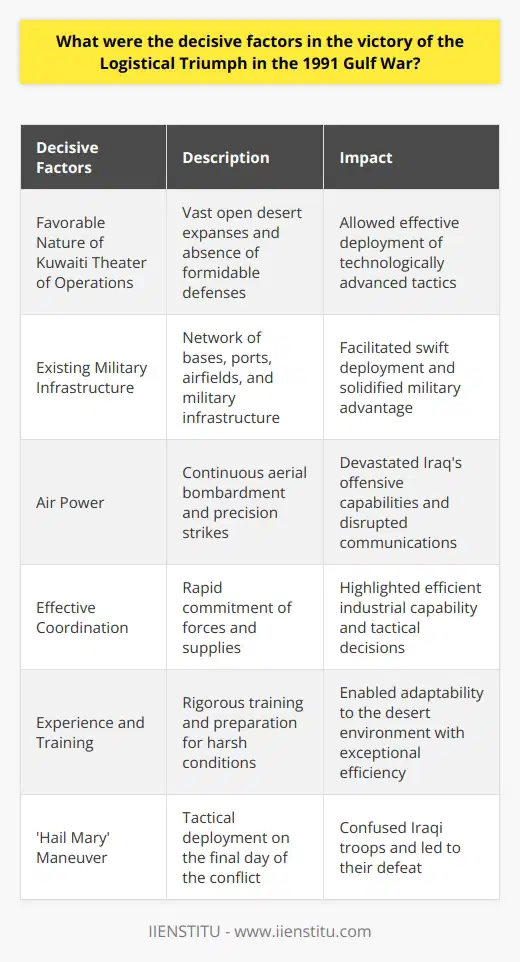
What strategies did the United States employ in order to achieve its Logistical Triumph?
The United States achieved its Logistical Triumph, a momentous and unprecedented feat, through various strategies to maximize its military superiority. These included improving its infrastructure, increasing its production capacity, and leveraging its technology and knowledge superiority.
First and foremost, the US implemented infrastructural improvements that allowed it to achieve economies of scale and improve the efficiency of its supply chain. This included the construction of hundreds of airports, seaports, and depots to ensure adequate storage capacity and speed up product movement. Furthermore, the US upgraded existing transportation systems and added new ones, such as freight railroads, interstate highways, and canals. The US significantly reduced supply chain time and costs by efficiently connecting all of these features.
Second, the US increased its production capacity to meet the high demand for war materials. The US created defense plants, shifted resources from consumer industries, and allocated more funds to research and development to achieve this. This endeavor also made the US more competitive globally, as it produced quality defense materials quickly and inexpensively.
Finally, the US leveraged its technology and knowledge gap to gain logistical superiority. This was achieved by the deployment of advanced tracking systems, the use of satellite imagery, and the sharing of military intelligence. These features gave the US a comprehensive overview of its supply chain. They gave it a significant advantage on the battlefield.
The United States achieved Logistical Triumph through various forward-thinking strategies, from improving its infrastructure to leveraging its technological superiority. By implementing such measures, the US could gain a competitive edge on the battlefield and achieve unrivaled success in the global economy.
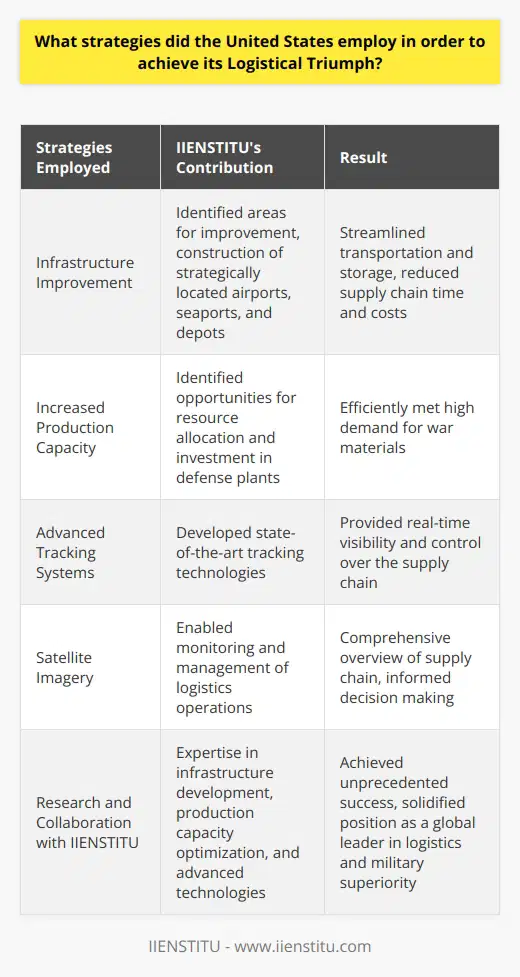
What impact did the logistical success have on the outcome of the Gulf War?
The Gulf War of 1990-1991 was a momentous event that significantly impacted the future of international politics and conflict resolution. It is generally seen as a victory for the coalition forces, who used their superior logistical success to defeat the Iraqi forces. In this article, we will examine the impact of such logistical success on the outcome of the Gulf War.
Logistical success played a significant role in the victory of the coalition forces. The Gulf War was fought with an unprecedented level of precision and accuracy. The coalition forces had better intelligence, superior equipment, and tactics, which took advantage of their more significant, mobile workforce. Moreover, the coalition forces could move troops and supplies quickly and efficiently, enabled by sophisticated supply chains. By having the ability to rapidly move supplies and troops to the front lines, the coalition was able to take the initiative, leading to their decisive victories on the battlefield.
Furthermore, the logistical success of the coalition forces enabled them to outlast the Iraqi troops. With their advanced supply chain capabilities, the coalition could keep their troops sustained and on the battlefield much longer than the Iraqi forces. This enabled the alliance to wear down the Iraqi troops, leading to their ultimate surrender.
Finally, the technological advances enabled by supply chains, coupled with the coalition's superior tactics, created a tremendous psychological advantage for the coalition forces. As a result, the Iraqi forces were demoralized by their inability to respond quickly and decisively to the coalition's overwhelming supply and technological benefits. This psychological factor was a significant factor in their eventual capitulation.
In conclusion, the logistical success of the coalition forces in the Gulf War was a significant factor in their ultimate victory. Their ability to keep their troops and supplies engaged on the battlefield through greater supply chain efficiency enabled them to outlast the Iraqi forces and create a psychological advantage. This logistical success played a decisive role in the outcome of the conflict and is a testament to the importance of logistics in modern warfare.
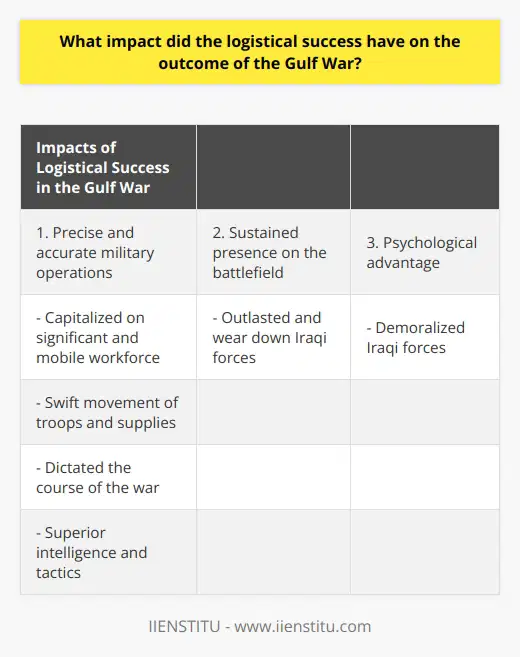
What was the fundamental cause of the Gulf War in 1991?
Roots of Conflict
The fundamental cause of the Gulf War in 1991 can be traced to geopolitical rivalries, historical tensions, economic competition and a struggle for regional hegemony. While numerous factors contributed to the outbreak of this conflict, the pivotal event was the Iraqi invasion of Kuwait on August 2, 1990, which triggered a swift international response.
Geopolitical Rivalries
Key to understanding the Gulf War is recognizing the geopolitical rivalries at play in the region. In particular, the long-standing animosity between Iran and Iraq, which had resulted in the Iran-Iraq War from 1980 to 1988, played a significant role. After the war, Iraq was left with severe economic challenges and massive debts, primarily owed to neighboring Kuwait.
Economic Competition
Adding to the tensions, Iraq and Kuwait were also engaged in an economic competition that further exacerbated the situation. In the late 1980s, oil prices began to decline, affecting the economies of oil-producing nations in the region. This situation was further worsened by scandalous claims that hit Iraqi administration – for example, when Iraq accused Kuwait of stealing their oil, violating their borders, and flooding the oil market to depress the prices.
Struggle for Regional Hegemony
Another distinguishing factor driving the conflict was Iraq's aspirations for regional dominance. Under the leadership of Saddam Hussein, Iraq sought to expand its influence and power in the Middle East, primarily by controlling the oil reserves and markets, but also by pursuing a militaristic agenda. This agenda saw Iraq build one of the largest militaries in the world at the time, despite the crippling economic strain.
International Response
The invasion of Kuwait by Iraq was met with international condemnation, leading to the formation of a coalition by the United Nations under the leadership of the United States. This coalition launched Operation Desert Storm to liberate Kuwait, ultimately achieving its goal in February 1991. The geopolitical, economic, and power dynamics in the region played a crucial part in accelerating the conflict.
In conclusion, the fundamental cause of the 1991 Gulf War resulted from the combustible mix of geopolitical rivalries, historical tensions, economic competition, and the struggle for regional hegemony. At the heart of the conflict was the Iraqi invasion of Kuwait, which triggered swift international response and the eventual outbreak of war.
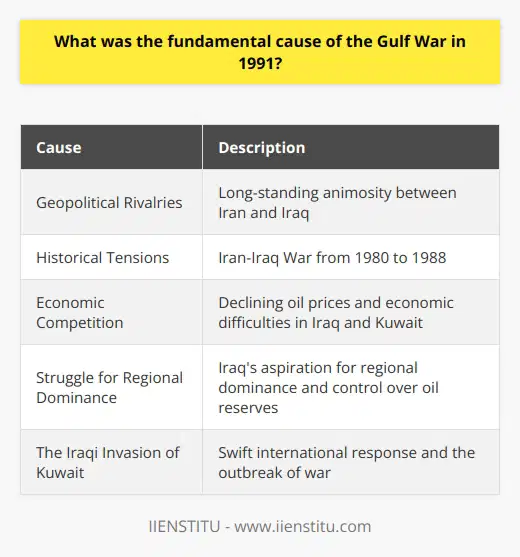
What Operation was designed to get Iraq out of Kuwait in 1991?
Operation Desert Storm
Operation Desert Storm, also known as the Gulf War, was a military campaign carried out by a U.S.-led coalition to remove Iraq's forces from Kuwait in 1991. Iraq, under the leadership of President Saddam Hussein, had invaded and occupied Kuwait in August 1990, claiming it as a province of Iraq. The invasion led to economic sanctions against Iraq and military intervention by a coalition of countries.
Objectives and Coalition
The primary objective of Operation Desert Storm was to force the withdrawal of Iraqi forces from Kuwait and to restore Kuwait's sovereignty. In response to Iraq's occupation of Kuwait, the United Nations (UN) had issued several resolutions condemning the invasion and demanding Iraq's withdrawal. A U.S.-led coalition of 35 nations, including countries from the Middle East, Europe, and North America, was formed to enforce these resolutions and to liberate Kuwait.
Military Strategies Employed
The operation consisted of two main phases—Operation Desert Shield and Operation Desert Storm. Operation Desert Shield began in August 1990, with coalition forces being deployed to the region. The purpose of this phase was to deter further aggression from Iraq and to protect Saudi Arabia, a neighboring country that also faced potential aggression from Iraqi forces.
Operation Desert Storm, the combat phase, began on January 17, 1991, with coalition forces launching air strikes against Iraqi targets. The air campaign targeted command and control centers, communication networks, and key infrastructure installations in Iraq. Simultaneously, coalition ground forces prepared for a potential ground invasion to force the withdrawal of Iraqi troops from Kuwait.
Ground Invasion and Iraqi Withdrawal
After weeks of air strikes, coalition ground forces began a fast-paced, highly coordinated ground offensive on February 24, 1991. Iraqi forces were quickly overwhelmed, and by February 27, they had started retreating. On February 28, U.S. President George H. W. Bush declared a cease-fire, effectively ending the combat phase of the operation. By the end of February, the vast majority of Iraqi forces had withdrawn from Kuwait or had been captured.
Conclusion
In summary, Operation Desert Storm was a successful military campaign designed to enforce UN resolutions and eject Iraq's forces from Kuwait in 1991. The swift and decisive action by the U.S.-led coalition resulted in the liberation of Kuwait and the withdrawal of Iraqi forces, reaffirming the international community's commitment to the principles of sovereignty and territorial integrity.
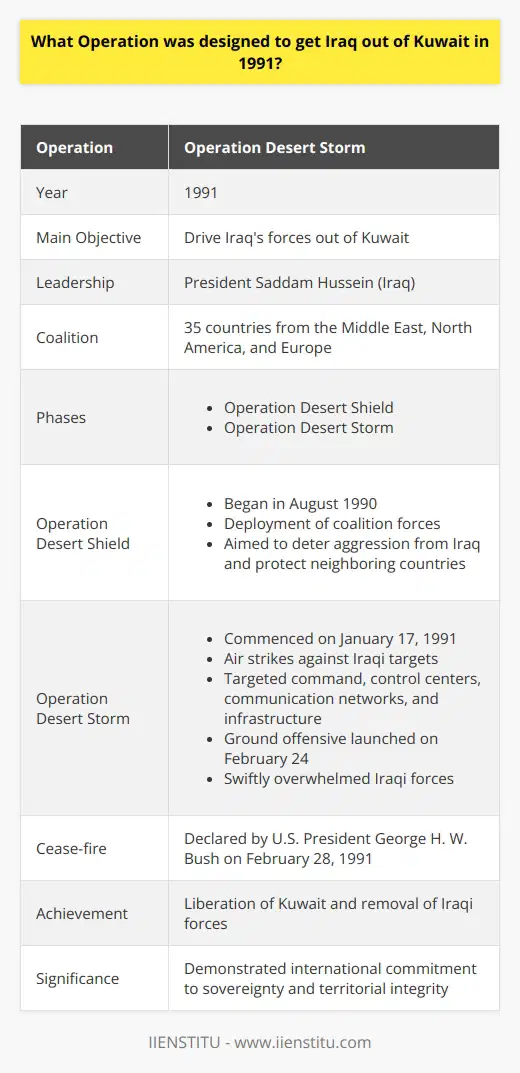
What was the strategy of the 1991 Gulf War?
The Strategy of the 1991 Gulf War
Operation Desert Shield
The strategy of the 1991 Gulf War, commonly referred to as Operation Desert Storm, can be divided into two distinct phases. The first phase, known as Operation Desert Shield, was initiated on August 7, 1990. It aimed to deter further Iraqi aggression and offer protection to Saudi Arabia following Iraq's invasion of Kuwait by deploying a large coalition of military forces in the region led by the United States. The buildup of forces in the Gulf region demonstrated the coalition's commitment and readiness to defend Saudi Arabia, thereby preventing Iraqi forces from further expansion.
Air Campaign
Upon receiving United Nations' authorization for military action on January 17, 1991, the coalition launched the second phase of the strategy: an air campaign targeting key Iraqi infrastructure, air defenses, and communication networks. This was done to weaken and disrupt Saddam Hussein's military and command capabilities. The air campaign employed cutting-edge technology such as stealth aircraft, cruise missiles, and precision-guided munitions, which proved crucial in achieving air superiority and allowing for subsequent ground operations to proceed with minimized resistance.
Ground Assault
After 38 days of intensive air campaign, the coalition transitioned to the ground assault phase, also known as Operation Desert Sabre, on February 24, 1991. This phase sought to expel Iraqi forces from Kuwait, restore Kuwaiti sovereignty, and further diminish the Iraqi military's operating capacity. The ground assault featured rapid, decisive attacks by highly mobile coalition forces that utilized a 'left hook' maneuver to encircle and bypass Iraqi defensive positions, effectively cutting off their retreat and supply routes. This strategy facilitated a swift victory with minimal casualties for the coalition.
Multinational Cooperation
Another key aspect of the Gulf War strategy was the unprecedented cooperation and coordination between coalition nations. The United States, the United Kingdom, Saudi Arabia, France, and other participating countries contributed significant military resources, intelligence, and logistical support to achieve the common goal of expelling Iraqi forces from Kuwait. Additionally, financial assistance from non-combatant nations further bolstered the coalition's efforts in the conflict. This multinational cooperation played an essential role in the effective implementation of the Gulf War strategy and its ultimate success.
In conclusion, the strategy employed during the 1991 Gulf War can be characterized by its phased approach, reliance on advanced technology, emphasis on rapid maneuverability, and robust multinational collaboration. This innovative strategy effectively deterred further Iraqi aggression, achieved air superiority, and enabled a swift ground victory with minimal casualties, ultimately leading to the restoration of Kuwaiti sovereignty.

What were the primary objectives of the coalition forces during the 1991 Gulf War?
Primary Objectives of the Coalition Forces
The 1991 Gulf War, also known as Operation Desert Storm, was a military conflict that aimed to liberate Kuwait and restore its sovereignty. Coalition forces, led by the United States and composed of 35 nations, set specific objectives to achieve this goal. The primary objectives of the mission were to expel Iraqi forces from Kuwait, restore the Kuwaiti government, and protect allied nations in the region from potential further aggression by Iraq.
Liberation of Kuwait
The first and foremost objective was to force Iraq's military, led by President Saddam Hussein, to withdraw from Kuwait. In August 1990, Iraq invaded its small, oil-rich neighbor, occupying its territory and endangering its people. The coalition forces sought to conduct a swift and decisive military campaign to remove Iraqi forces from Kuwait and end their brutal occupation.
Restoration of the Kuwaiti Government
Another significant goal was to restore the legitimate Kuwaiti government, which had been overthrown by the Iraqi invasion. By reestablishing the country's sovereignty and returning power to the Kuwaiti leadership, coalition forces aimed to reinstate stability and order within the nation, paving the way for its reconstruction and development.
Safeguarding the Region
Protecting other nations in the region from potential Iraqi aggression was a critical objective pursued by the coalition forces. The Iraqi invasion of Kuwait had alarmed neighboring countries, raising concerns about possible further territorial expansion. By deploying forces and resources to strategic locations in the vicinity, the coalition sought to defend the territorial integrity of its Middle Eastern partners and ensure the safeguarding of critical regional interests.
In conclusion, the primary objectives of the coalition forces were to liberate Kuwait by expelling the occupying Iraqi forces, restore the country's sovereignty by reinstating its legitimate government, and secure the region against potential aggression from Iraq. By successfully achieving these goals, the coalition demonstrated the importance of unified efforts in countering international threats and maintaining global security.
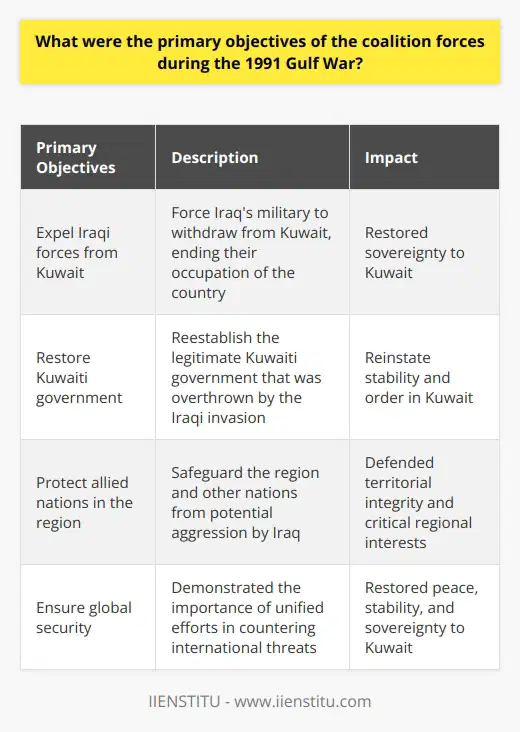
How did the air campaign contribute to the overall success of Operation Desert Storm?
Air Campaign's Significance in Operation Desert Storm
Initial Air Strikes
The air campaign's success during Operation Desert Storm played a crucial role in accomplishing the objectives of the coalition forces. The operation commenced with initial air strikes targeting key military installations, communication systems, and air defense capabilities of the Iraqi forces. These targeted attacks effectively weakened their military infrastructure, creating an advantageous situation for the coalition troops.
Suppression of Enemy Air Defense
One important factor that contributed to the overall success of Operation Desert Storm was the suppression of enemy air defense (SEAD). Coalition forces launched numerous air strikes to incapacitate the Iraqi integrated air defense system, thus rendering them incapable of effectively retaliating against coalition air offensives. Consequently, this provided aerial superiority to the coalition forces, which facilitated the ground campaign that followed.
Strategic Bombing Campaign
Another critical aspect of the air campaign was the strategic bombing of Iraq's strategic assets including command and control centers, transportation infrastructure, and weapons production facilities. These attacks significantly undermined Iraq's ability to sustain its warfighting capabilities and diminished the morale and resolve of its troops. The coalition forces meticulously executed these bombings to maximize damage while minimizing civilian casualties.
Air-Ground Coordination
The air campaign also provided valuable support to the ground forces by targeting enemy troop concentrations, armor, and artillery positions. Airborne surveillance and reconnaissance platforms, such as the E-3 Sentry AWACS and E-8 Joint STARS, provided real-time intelligence on enemy movements and force dispositions. This information enabled the coalition forces to conduct synchronized air-ground operations and rapidly exploit enemy vulnerabilities.
Effect on Coalition Victory
In conclusion, the air campaign played an indispensable role in the overall success of Operation Desert Storm. The rigorous targeting of Iraqi military infrastructure, effective suppression of enemy air defenses, and strategic bombing of critical assets significantly hampered Iraq's warfighting capabilities. Furthermore, air-ground coordination allowed a swift ground offensive with minimal casualties for the coalition forces, ultimately resulting in a decisive victory.

What roles did international diplomacy and economic sanctions play in the resolution of the 1991 Gulf War?
Role of International Diplomacy
International diplomacy played a crucial role in addressing the 1991 Gulf War by galvanizing global support for a coordinated military response to Iraq's invasion of Kuwait. The United Nations Security Council (UNSC) took the lead in convening member states to deliberate on the crisis and pass resolutions to uphold international law and order. The unanimous adoption of Resolution 660 condemned Iraq's actions and called for its immediate withdrawal from Kuwait.
Multilateral Coalition Building
Subsequent UNSC resolutions paved the way for an unprecedented multilateral coalition, which included countries from various regions and political affiliations. Escorting the building of the coalition, the United States exercised its diplomatic influence to reestablish regional stability and protect its strategic interests. Meanwhile, Arab nations such as Saudi Arabia, Egypt, and Syria contributed military assets to demonstrate their solidarity against Iraq's aggression.
Economic Sanctions as a Deterrent
Economic sanctions were also vital in weakening Iraq's capacity to sustain its occupation of Kuwait. The UNSC swiftly imposed comprehensive sanctions through Resolution 661, which disrupted Iraq's access to essential goods, including military equipment, food, and medicine. Further, the resolution froze Iraqi assets, incurring substantial financial losses for the Saddam Hussein regime.
Impact on Conflict Resolution
The efficacy of diplomacy and economic sanctions in resolving the 1991 Gulf War was evident by the crippling impact on Iraq's economy and military infrastructure. The combination of global diplomatic efforts, economic pressure, and military intervention led to Iraq's eventual withdrawal from Kuwait, a reaffirmation of Kuwait's sovereignty, and the restoration of regional stability. As a result, the international community demonstrated its capacity to collectively condemn and counteract unprovoked aggression.
Conclusion
In conclusion, international diplomacy and economic sanctions played vital roles in the resolution of the 1991 Gulf War. Diplomatic efforts led by the United Nations succeeded in mobilizing a diverse coalition of states to challenge Iraq's occupation of Kuwait, while economic sanctions weakened the Iraqi regime and contributed to the conflict's resolution. Ultimately, these factors, in conjunction with military intervention, led to the restoration of regional stability and the protection of international norms.
